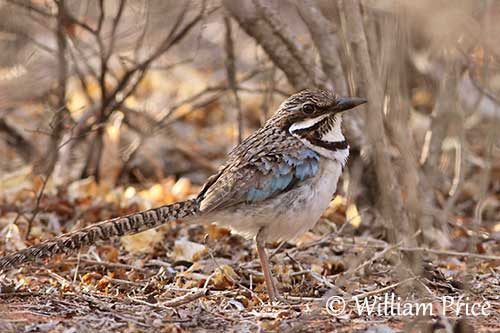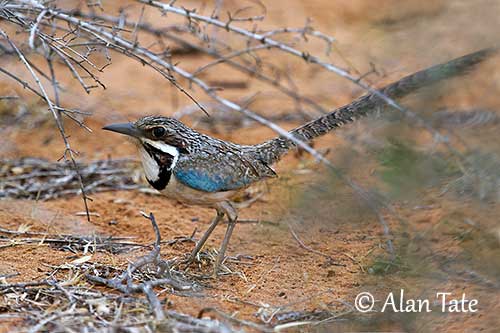
Text by Nicole Bouglouan
Photographers:
John Anderson
John Anderson Photo Galleries
Jean Michel Fenerole
Photos d’Oiseaux du monde
William Price
PBase-tereksandpiper & Flickr William Price
Dubi Shapiro
Dubi Shapiro Photo Galleries & Dubi Shapiro's Pictures on IBC
Alan & Ann Tate
AA Bird Photography
Sources:
HANDBOOK OF THE BIRDS OF THE WORLD Vol 6 by Josep del Hoyo-Andrew Elliott-Jordi Sargatal - Lynx Edicions, 2001 - ISBN: 848733430X
HANDBOOK OF THE BIRDS OF THE WORLD Vol 6 by Josep del Hoyo-Andrew Elliott-Jordi Sargatal - Lynx Edicions, 2001 - ISBN: 848733430X
Birds of Madagascar and the Indian Ocean Islands Par Roger Safford, Adrian Skerrett, Frank Hawkins– ISBN:1472924118, 9781472924117- Editeur: Bloomsbury Publishing, 2015
The Birds of Africa: Volume VIII: The Malagasy Region: Madagascar, Seychelles, Comoros, Mascarenes - Par Roger Safford, Frank Hawkins – ISBN: 1408190494, 9781408190494- Editeur: A&C Black, 2013
Birds of Madagascar: A Photographic Guide Par Pete Morris, Frank Hawkins – ISBN: 0300077556, 9780300077551- Editeur: Yale University Press, 1998
Wildlife of Madagascar par Ken Behrens, Keith Barnes - ISBN: 140088067X, 9781400880676 – Editeur: Princeton University Press, 2016
Birds of the Indian Ocean Islands Par Ian Sinclair, Olivier Langrand - ISBN: 1868729567, 9781868729562- Editeur: Struik, 2003
The Natural History of Endemic Families and Sub-families of Birds of Madagascar
Creagus - GROUND-ROLLERS Brachypteraciidae
FAMILY BRACHYPTERACIIDAE
Ground-rollers
The family Brachypteraciidae is endemic to Madagascar. The ground-rollers are closely related to the rollers (Coraciidae) and the Cuckoo-roller (Leptosomidae), and all were considered a single family until recently. However, due to different behaviour, plumage and other morphological features, the ground-rollers have now their own family.
From J. Cracraft, the Brachypteraciidae are the result of an invasion of rollers from Africa.
This family is represented by five extant species and four genera described between 1833 and 1895. One more species was recently described from 2000-year-old subfossil remains excavated in SW Madagascar, and named Brachypteracias langrandi or Lagrand’s Ground-Roller. It became extinct after the Holocene, probably following natural changes in the environment.
The ground-rollers are threatened by habitat loss, through degradation and fragmentation of the forest, human activities and hunting pressure. They are hunted for food because they are easy targets spending much time on the ground.
Four species occur in the eastern rainforest, whereas the fifth species, the Long-tailed Ground-Roller, is restricted to the spiny desert of SW Madagascar.

The ground-rollers have basically cryptic plumage on the upperparts, with bronzy-green and brownish colours. But head, flight-feathers and outer rectrices are usually brighter coloured. The stout body, the strong, long legs and the zygodactylous feet reflect their terrestrial lifestyle. They have stout bill with slit-like nostrils at base and long bristles around it, and the long tongue has a brush-like tip. These features are probably an adaptation to catch insects that are their main food.
They are very active while searching for prey on the ground. They feed on invertebrates (insects) and sometimes small vertebrates such as small chameleons. They climb and jump over stones, branches and various obstacles, make short runs, sally-glean and investigate dead stumps and thick leaf litter. They perch in tree but on low branches, sometimes higher while watching for prey. If they are threatened, they prefer to run away instead to take-off, although they sometimes perform direct, noisy flight to escape a predator. The short wings do not allow long, sustained flight, and these birds only perform short-distance flights while foraging.

The Short-legged Ground-Roller of genus Brachypteracias is the only one that forages and nests in trees. It differs from congeners by longer wings, shorter legs and plump appearance. It has conspicuous head and throat pattern, with combination of white spots, crescent-shaped breast band and bars. The contrasted brown and white head pattern with the prominent whitish supercilium is very distinctive.
Unlike other species, this one nests in tree cavity above the ground instead in burrow. It is more arboreal and forages in the canopy, hunts by sally-gleaning or pursues a prey in flight, even in closed environment. It is considered the most primitive living ground-roller.

All species have characteristic head pattern, but the Pitta-like Ground-Roller is probably the most beautiful with its bright blue head and white bib. The Rufous-headed Ground-Roller shows fine black-and-white throat pattern and bright rufous plumage. Both species are in the genus Atelornis. They forage on the ground where the main technique is “wait-and-run”. They feed on a variety of invertebrates, mainly insects, and occasionally take small chameleons.

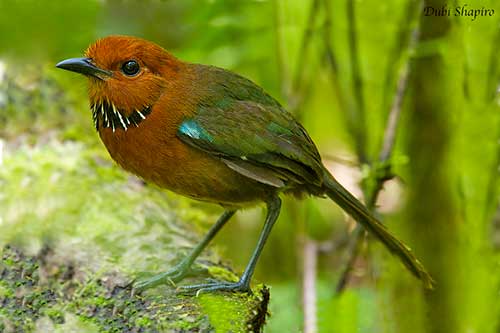
The Scaly Ground-Roller of genus Geobiastes has finely scaled pattern overall, allowing the bird to blend in with the vegetation of the dark forest. It forages on the ground, probing the leaf litter and waiting quietly for prey before to pursue some insect.

The four previous species frequent the eastern humid tropical forest between sea-level and 1000/1600 metres of elevation. They favour undisturbed rainforest with thick leaf litter, dense understorey and damp soil.
However, all five species need areas of undisturbed forest for their survival.
Unlike other species, the Long-tailed Ground-Roller of genus Uratelornis occurs in the sub-arid spiny desert from sea-level to 100 metres of elevation. It is restricted to a narrow coastal strip in SW Madagascar. It is very distinctive with its striking head pattern and its long tail (30 cm). It is superficially reminiscent of the Greater Roadrunner (Geococcyx californianus) of North America. It feeds on various invertebrates and also reptiles and frogs, and forages almost exclusively on the ground. Its strong legs and feet allow it to run quickly while hunting, but it is a poor flier.
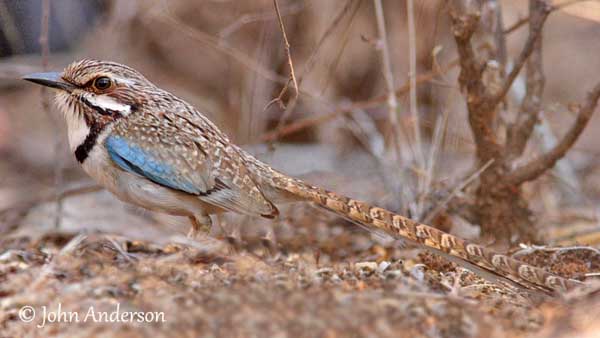
The ground-rollers are furtive, shy, elusive birds with retiring habits, and they are difficult to study. They are usually diurnal, but some authors suggest that they could be active at dusk and even at night. But this behaviour requires more information.
They are solitary during most of the year, but they can be seen in pairs during the breeding season and in small family groups after the nesting period.
The five species are sedentary on the island and have stable territories. They may perform short-distance seasonal movements related to changes in the weather, but they remain on the island.


They become more territorial during the breeding season and give far-carrying territorial calls, often before sunrise between September and February. The four rainforest ground-rollers utter similar low, resonant and guttural notes described as series of “whoop” or “boob” sounds.
The call of the Long-tailed Ground-Roller is slightly different. It gives a series of soft notes “boobooboo…” or a series of chuckling “too-tuc too-tuc too-tuc…” notes. These calls can be heard before sunrise, or sometimes in the late afternoon and even at night.
They call from perches higher than their usual foraging level. The territorial neighbours often perform countersinging.
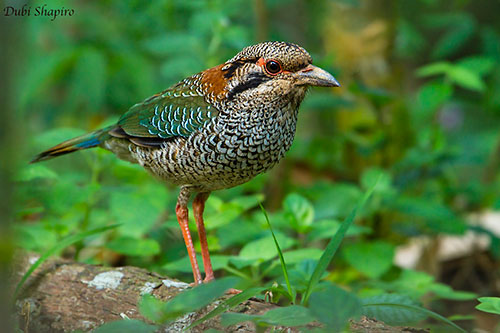
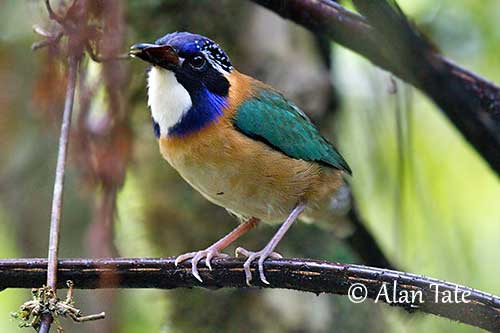
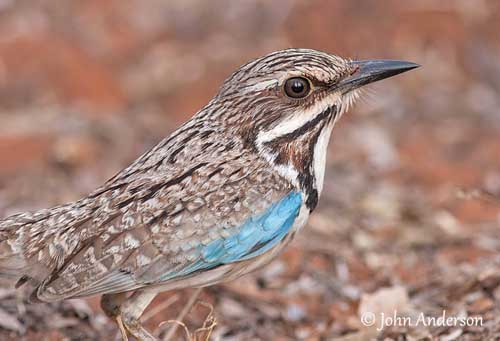
Both mates and members of a family give softer contact calls throughout the day, to establish or maintain contact, and especially to initiate courtship feeding. The alarm calls are harsher, described as a hissing “kwish-sh” or louder “tac tac tashhhhhhhhrr”. Other calls can be heard, usually related to courtship, displays and excitement.
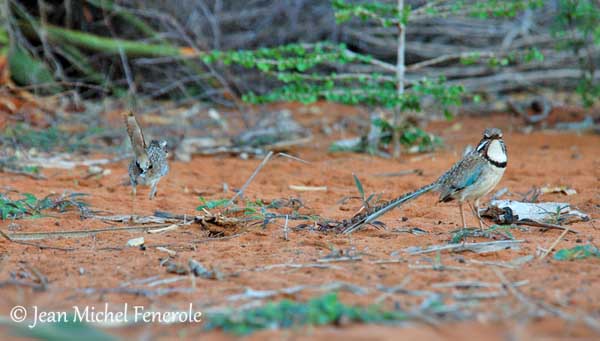
The ground-rollers appear to be socially monogamous during the breeding season, from September to February. They defend the territory and gives advertising calls.
Three species, the Short-legged Ground-Roller, the Scaly Ground-Roller and the Long-tailed Ground-Roller perform courtship feeding during this period.
They nest in excavated burrows in steep earth banks, below overhanging vegetation, but the Long-tailed Ground-Roller excavates its burrow in consolidated sand, usually in bare areas without grassy vegetation. The burrows have a nest-chamber with soft lining at the end, where the female lays her eggs and incubates.
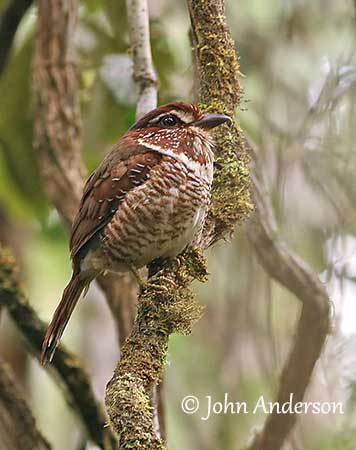

But the Short-legged Ground-Roller is the only member of this family that nests in tree cavities. The nest of this species was discovered and described only in 1996, in a natural cavity in dead branch of tree, about 18 metres above the ground.
The laying occurs mostly in December, and 1-4 white eggs are laid, usually two. The nesting behaviour is poorly known. The female appears to incubate alone while the male remains in the surroundings, and may sometimes feed the female during this period that lasts at least 18 days, but mostly 22-26 days.
The chicks are feathered about one week after hatching. The young are fed by both parents. The chicks of the Scaly Ground-Roller spend about 18 at nest, whereas those of the Short-legged Ground-Roller fledge at one month old.
The breeding success may be affected by predation by introduced Rattus rattus, and probably by snakes too.

The ground-rollers are threatened by degradation and destruction of their preferred habitat, the forest. Deforestation and fragmentation of the forest for agriculture expansion, degradation by slash-and-burn cultivation, commercial logging are the main threats for all species. In addition, they are affected by egg collection and hunting pressure.
The Long-tailed Ground-Roller is listed as Vulnerable and the population is declining.
The Pitta-like Ground-Roller is not globally threatened and breeds successfully in captivity.
The Rufous-headed Ground-Roller is currently listed as Near Threatened.
The Scaly Ground-Roller is listed as Near Threatened.
The Short-legged Ground-Roller is listed as Vulnerable.

All species are present in several protected areas, and some of them have been observed in other habitat types such as degraded forest or secondary growth, indicating some adaptation to other environment. But they are patchily distributed, and the remaining habitat is under pressure from increasing human population and continuous deforestation.
Conservation programs are needed to ensure the future survival of the Brachypteraciidae. The ecotourism is playing a significant part in the action for the preservation of the biodiversity, but the habitat is highly degraded on the island and requires serious conservation action. More studies must be done to know the habitat requirements of each species and the size of their populations, in order to protect their habitat and their food resources, and to ensure their future.
